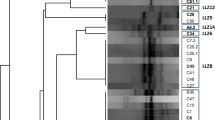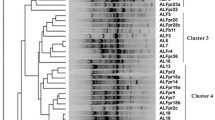Abstract
Alfalfa (Medicago sativa L.) is an important crop worldwide whose cropping in acid soils is hampered by the poor nodulation and yield commonly attributed to the sensitivity of its endosymbionts to acid pH. In this work, we isolated several acid-tolerant strains from alfalfa nodules in three acid soils in northwestern Spain. After grouping by RAPD fingerprinting, most strains were identified as Ensifer meliloti and only two strains as Ensifer medicae according to their 16S–23S intergenic spacer (ITS) sequences that allowed the differentiation of two groups within each one of these species. The two ITS groups of E. meliloti and the ITS group I of E. medicae have been previously found in Medicago nodules; however, the group II of E. medicae has been only found to date in Prosopis alba nodules. The analysis of the nodC gene showed that all strains isolated in this study belong to the symbiovar meliloti, grouping with the type strains of E. meliloti or E. medicae, but some harboured nodC gene alleles different from those found to date in alfalfa nodules. The strains of E. medicae belong to the symbiovar meliloti which should be also recognised in this species, although they harboured a nodC allele phylogenetically divergent to those from E. meliloti strains. Microcosm experiments showed that inoculation of alfalfa with selected acid-tolerant strains significantly increased yields in acid soils representing a suitable agricultural practice for alfalfa cropping in these soils.



Similar content being viewed by others
References
Altschul SF, Gish W, Miller W, Myers EW, Lipman DJ (1990) Basic local alignment search tool. J Mol Biol 215:403–410
Brockwell J, Pilka A, Holliday RA (1991) Soil-pH is a major determinant of the numbers of naturally-occurring Rhizobium meliloti in noncultivated soils in Central New-South-Wales. Aust J Exp Agr 31:211–219
Capela D, Barloy-Hubler F, Gouzy J, Bothe G, Ampe F, Batut J, Boistard P, Becker A, Boutry M, Cadieu E, Dréano S, Gloux S, Godrie T, Goffeau A, Kahn D, Kiss E, Lelaure V, Masuy D, Pohl T, Portetelle D, Pühler A, Purnelle B, Ramsperger U, Renard C, Thébault P, Vandenbol M, Weidner S, Galibert F (2001) Analysis of the chromosome sequence of the legume symbiont Sinorhizobium meliloti strain 1021. Proc Natl Acad Sci U S A 98:9877–9882
Charman N, Ballard RA, Humphries AW, Auricht GC (2008) Improving lucerne nodulation at low pH: contribution of rhizobial and plant genotype to the nodulation of lucerne seedlings growing in solution culture at pH 5. Aust J Exp Agr 48:512–517
Cobo-Díaz JF, Martínez-Hidalgo P, Fernández-González AJ, Martínez-Molina E, Toro N, Velázquez E, Fernández-López M (2014) The endemic Genista versicolor from sierra Nevada national park in Spain is nodulated by putative new Bradyrhizobium species and a novel symbiovar (sierranevadense). Syst Appl Microbiol 37:177–185
Del Papa MF, Pistorio M, Balague LJ, Draghi WO, Wegener C, Perticari A, Niehaus K, Lagares A (2003) A microcosm study on the influence of pH and the host-plant on the soil persistence of two alfalfa-nodulating rhizobia with different saprophytic and symbiotic characteristics. Biol Fertil Soils 39:112–116
del Villar M, Rivas R, Peix A, Mateos PF, Martínez-Molina E, van Berkum P, Willems A, Velázquez E (2008) Stable low molecular weight RNA profiling showed variations within Sinorhizobium meliloti and Sinorhizobium medicae nodulating different legumes from the alfalfa cross-inoculation group. FEMS Microbiol Lett 282:273–281
Djedidi S, Yokoyama T, Tomooka N, Ohkama-Ohtsu N, Risal CP, Abdellye C, Sekimoto H (2011) Phenotypic and genetic characterization of rhizobia associated with alfalfa in the Hokkaido and Ishigaki regions of Japan. Syst Appl Microbiol 34:453–461
Elboutahiri N, Thami-Alami I, Udupa SM (2010) Phenotypic and genetic diversity in Sinorhizobium meliloti and S. medicae from drought and salt affected regions of Morocco. BMC Microbiol 10:15
Faghire M, Mandri B, Oufdou K, Bargaz A, Ghoulam C, Ramírez-Bahena MH, Velázquez E, Peix A (2012) Identification at the species and symbiovar levels of strains nodulating Phaseolus vulgaris in saline soils of the Marrakech region (Morocco) and analysis of the otsA gene putatively involved in osmotolerance. Syst Appl Microbiol 35:156–164
Ferreira L, Sánchez-Juanes F, García-Fraile P, Rivas R, Mateos PF, Martínez-Molina E, González-Buitrago JM, Velázquez E (2011) MALDI-TOF mass spectrometry is a fast and reliable platform for identification and ecological studies of species from family Rhizobiaceae. PLoS ONE 6(5):15
Galardini M, Pini F, Bazzicalupo M, Biondi EG, Mengoni A (2013) Replicon-dependent bacterial genome evolution: the case of Sinorhizobium meliloti. Genome Biol Evol 5:542–558
Glenn AR, Dilworth MJ (1994) The life of root-nodule bacteria in the acidic underground. FEMS Microbiol Lett 123:1–9
Gubry-Rangin C, Béna G, Cleyet-Marel JC, Brunel B (2013) Definition and evolution of a new symbiovar, sv. rigiduloides, among Ensifer meliloti efficiently nodulating Medicago species. Syst Appl Microbiol 36:490–496
Guo JH, Liu XJ, Zhang Y, Shen JL, Han WX, Zhang WF, Christie P, Goulding KWT, Vitousek PM, Zhang FS (2010) Significant acidification in major Chinese croplands. Science 327:1008–1010
Helrich K (1990). Fertilizers. In: Helrich K (ed) Methods of analysis of the Association of Official Analytical Chemists. Fifteenth edition, vol 1. AOAC, Arlington, VA, pp. 9–39
Howieson JG, Ewing MA, Dantuono MF (1988) Selection for acid tolerance in Rhizobium meliloti. Plant Soil 105:179–188
Iglesias O, Rivas R, García-Fraile P, Abril A, Mateos PF, Martínez-Molina E, Velázquez E (2007) Genetic characterization of fast-growing rhizobia able to nodulate Prosopis alba in North Spain. FEMS Microbiol Lett 277:210–216
Kimura M (1980) A simple method for estimating evolutionary rates of base substitutions through comparative studies of nucleotide sequences. J Mol Evol 16:111–120
Laguerre G, Nour SM, Macheret V, Sanjuán J, Drouin P, Amarger N (2001) Classification of rhizobia based on nodC and nifH gene analysis reveals a close phylogenetic relationship among Phaseolus vulgaris symbionts. Microbiology-UK 147:981–993
Langer H, Nandasena KG, Howieson JG, Jorquera M, Borie F (2008) Genetic diversity of Sinorhizobium meliloti associated with alfalfa in Chilean volcanic soils and their symbiotic effectiveness under acidic conditions. World J Microbiol Biotechnol 24:301–308
Martínez-Abarca F, Martínez-Rodríguez L, López-Contreras JA, Jiménez-Zurdo JI, Toro N (2013) Complete genome sequence of the alfalfa symbiont Sinorhizobium/Ensifer meliloti strain GR4. Genome Announc 1(1):e00174–12
Mnasri B, Mrabet M, Laguerre G, Aouani ME, Mhamdi R (2007) Salt-tolerant rhizobia isolated from a Tunisian oasis that are highly effective for symbiotic N2-fixation with Phaseolus vulgaris constitute a novel biovar (bv. mediterranense) of Sinorhizobium meliloti. Arch Microbiol 187:79–85
Mnasri B, Badri Y, Saidi S, de Lajudie P, Mhamdi R (2009) Symbiotic diversity of Ensifer meliloti strains recovered from various legume species in Tunisia. Syst Appl Microbiol 32:583–592
Moschetti G, Peluso A, Protopapa A, Anastasio M, Pepe O, Defez R (2005) Use of nodulation pattern, stress tolerance, nodC gene amplification, RAPD-PCR and RFLP-16S rDNA analysis to discriminate genotypes of Rhizobium leguminosarum biovar viciae. Syst Appl Microbiol 28:619–631
Mulas D, García-Fraile P, Carro L, Ramírez-Bahena MH, Casquero P, Velázquez E, González-Andrés F (2011) Distribution and efficiency of Rhizobium leguminosarum strains nodulating Phaseolus vulgaris in Northern Spanish soils: selection of native strains that replace conventional N fertilization. Soil Biol Biochem 43:2283–2293
Munns DN (1968) Nodulation of Medicago sativa in solution culture. I. Acid-sensitive steps. Plant Soil 28:129–146
Paffetti D, Scotti C, Gnocchi S, Fancelli S, Bazzicalupo M (1996) Genetic diversity of an Italian Rhizobium meliloti population from different Medicago sativa varieties. Appl Environ Microbiol 62:2279–2285
Peix A, Ramírez-Bahena MH, Velázquez E, Bedmar EJ (2015) Bacterial associations with legumes. Crit Rev Plant Sci 34:17–42
Perret X, Staehelin C, Broughton WJ (2000) Molecular basis of symbiotic promiscuity. Microbiol Mol Biol Rev 64:180–201
Pinkerton A, Simpson J (1986) Responses of some crop plants to correction of subsoil acidity. Aust J Exp Agr 26:107–113
Ramírez-Bahena MH, Chahboune R, Velázquez E, Gomez-Moriano A, Mora E, Peix A, Toro M (2013) Centrosema is a promiscuous legume nodulated by several new putative species and symbiovars of Bradyrhizobium in various American countries. Syst Appl Microbiol 36(6):392–400
Reeve W, Chain P, O’Hara G, Ardley J, Nandesena K, Breu L, Tiwari R, Malfatti S, Kiss H, Lapidus A, Copeland A, Nolan M, Land M, Hauser L, Chang YJ, Ivanova N, Mavromatis K, Markowitz V, Kyrpides N, Gollagher M, Yates R, Dilworth M, Howieson J (2010) Complete genome sequence of the Medicago microsymbiont Ensifer (Sinorhizobium) medicae strain WSM419. Stand Genomic Sci 2:77–86
Rice WA, Penney DC, Nyborg M (1977) Effects of soil acidity on rhizobia numbers, nodulation and nitrogen-fixation by alfalfa and red-clover. Can J Soil Sci 57:197–203
Rigaud J, Puppo A (1975) Indole-3-acetic-acid catabolism by soybean bacteroids. J Gen Microbiol 88:223–228
Rivas R, García-Fraile P, Mateos PF, Martínez-Molina E, Velázquez E (2007a) Characterization of xylanolytic bacteria present in the bract phyllosphere of the date palm Phoenix dactylifera. Lett Appl Microbiol 44:181–187
Rivas R, Laranjo M, Mateos PF, Oliveira S, Martínez-Molina E, Velázquez E (2007b) Strains of Mesorhizobium amorphae and Mesorhizobium tianshanense, carrying symbiotic genes of common chickpea endosymbiotic species, constitute a novel biovar (ciceri) capable of nodulating Cicer arietinum. Lett Appl Microbiol 44:412–418
Rogel MA, Ormeño-Orrillo E, Martínez-Romero E (2011) Symbiovars in rhizobia reflect bacterial adaptation to legumes. Syst Appl Microbiol 34:96–104
Roumiantseva ML, Andronov EE, Sharypova LA, Dammann-Kalinowski T, Keller M, Young JPW, Simarov BV (2002) Diversity of Sinorhizobium meliloti from the central Asian alfalfa gene center. Appl Environ Microbiol 68:4694–4697
Saitou N, Nei M (1987) The neighbor-joining method: a new method for reconstructing phylogenetic trees. Mol Biol Evol 4:406–25
Sallet E, Roux B, Sauviac L, Jardinaud MF, Carrère S, Faraut T, de Carvalho-Niebel F, Gouzy J, Gamas P, Capela D, Bruand C, Schiex T (2013) Next-generation annotation of prokaryotic genomes with EuGene-P: application to Sinorhizobium meliloti 2011. DNA Res 20:339–353
Segundo E, Martínez-Abarca F, van Dillewijn P, Fernández-López M, Lagares A, Martínez-Drets G, Niehaus K, Pühler A, Toro N (1999) Characterisation of symbiotically efficient alfalfa-nodulating rhizobia isolated from acid soils of Argentina and Uruguay. FEMS Microbiol Ecol 28:169–176
Silva C, Kan FL, Martínez-Romero E (2007) Population genetic structure of Sinorhizobium meliloti and S. medicae isolated from nodules of Medicago spp. in Mexico. FEMS Microbiol Ecol 60:477–489
Stanley M, Britton RS, Christinat RA (2002) Success with lucerne. PIRSA Publishing Services, Topcrop
Tamura K, Peterson D, Peterson N, Stecher G, Nei M, Kumar S (2011) MEGA5: Molecular evolutionary genetics analysis using maximum likelihood, evolutionary distance, and maximum parsimony methods. Mol Biol Evol 28:2731–2739
Thompson JD, Gibson TJ, Plewniak F, Jeanmougin F, Higgins DG (1997) The CLUSTAL_X windows interface: flexible strategies for multiple sequence alignment aided by quality analysis tools. Nucleic Acids Res 25:4876–4882
van Berkum P, Elia P, Eardly BD (2010) application of multilocus sequence typing to study the genetic structure of megaplasmids in Medicago-nodulating rhizobia. Appl Environ Microbiol 76:3967–3977
Villegas MD, Rome S, Maure L, Domergue O, Gardan L, Bailly X, Cleyet-Marel JC, Brunel B (2006) Nitrogen-fixing sinorhizobia with Medicago laciniata constitute a novel biovar (bv. medicaginis) of S. meliloti. Syst Appl Microbiol 29:526–538
Vincent JM (1970) The cultivation, isolation and maintenance of rhizobia. In: Vincent JM (ed) A manual for the practical study of root-nodule bacteria. Blackwell Scientific Publications, Oxford, pp 1–13
Weidner S, Baumgarth B, Göttfert M, Jaenicke S, Pühler A, Schneiker-Bekel S, Serrania J, Szczepanowski R, Becker A (2013) Genome sequence of Sinorhizobium meliloti Rm41. Genome Announc 1(1):e00013–12
Zurdo-Piñeiro JL, García-Fraile P, Rivas R, Peix A, León-Barrios M, Willems A, Mateos PF, Martínez-Molina E, Velázquez E, van Berkum P (2009) Rhizobia from Lanzarote, the Canary Islands, that nodulate Phaseolus vulgaris have characteristics in common with Sinorhizobium meliloti isolates from mainland Spain. Appl Environ Microbiol 75:2354–2359
Acknowledgments
This work was supported by Junta de Castilla y León (JCyL, Spanish Regional Government) grant CSI02A09. MHRB is recipient of a JAE-Doc research contract of CSIC (Spain) cofinanced by ERDF. We thank M. Faghire for his valuable help in statistic analyses and A. Gómez-Moriano for technical assistance.
Author information
Authors and Affiliations
Corresponding author
Rights and permissions
About this article
Cite this article
Ramírez-Bahena, MH., Vargas, M., Martín, M. et al. Alfalfa microsymbionts from different ITS and nodC lineages of Ensifer meliloti and Ensifer medicae symbiovar meliloti establish efficient symbiosis with alfalfa in Spanish acid soils. Appl Microbiol Biotechnol 99, 4855–4865 (2015). https://doi.org/10.1007/s00253-014-6347-6
Received:
Revised:
Accepted:
Published:
Issue Date:
DOI: https://doi.org/10.1007/s00253-014-6347-6




